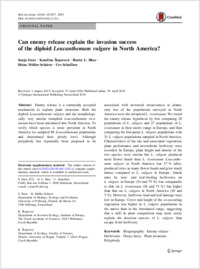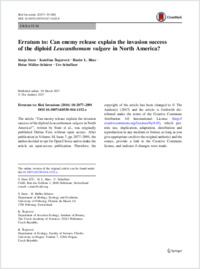Can enemy release explain the invasion success of the diploid Leucanthemum vulgare in North America?
- Stutz, Sonja CABI, Rue des Grillons 1, Delémont, Switzerland - Department of Biology, Ecology and Evolution, University of Fribourg, Switzerland
- Štajerová, Kateřina Department of Invasion Ecology, Institute of Botany, The Czech Academy of Sciences, Průhonice, Czech Republic - Department of Ecology, Faculty of Science, Charles University in Prague, Czech Republic
- Hinz, Hariet L. CABI, Rue des Grillons 1, Delémont, Switzerland
- Müller-Schärer, Heinz Department of Biology, Ecology and Evolution, University of Fribourg, Switzerland
- Schaffner, Urs CABI, Rue des Grillons 1, Delémont, Switzerland
-
29.04.2016
Published in:
- Biological Invasions. - 2016, p. 1–15
English
Enemy release is a commonly accepted mechanism to explain plant invasions. Both the diploid Leucanthemum vulgare and the morphologically very similar tetraploid Leucanthemum ircutianum have been introduced into North America. To verify which species is more prevalent in North America we sampled 98 Leucanthemum populations and determined their ploidy level. Although polyploidy has repeatedly been proposed to be associated with increased invasiveness in plants, only two of the populations surveyed in North America were the tetraploid L. ircutianum. We tested the enemy release hypothesis by first comparing 20 populations of L. vulgare and 27 populations of L. ircutianum in their native range in Europe, and then comparing the European L. vulgare populations with 31 L. vulgare populations sampled in North America. Characteristics of the site and associated vegetation, plant performance and invertebrate herbivory were recorded. In Europe, plant height and density of the two species were similar but L. vulgare produced more flower heads than L. ircutianum. Leucanthemum vulgare in North America was 17 % taller, produced twice as many flower heads and grew much denser compared to L. vulgare in Europe. Attack rates by root- and leaf-feeding herbivores on L. vulgare in Europe (34 and 75 %) was comparable to that on L. ircutianum (26 and 71 %) but higher than that on L. vulgare in North America (10 and 3 %). However, herbivore load and leaf damage were low in Europe. Cover and height of the co-occurring vegetation was higher in L. vulgare populations in the native than in the introduced range, suggesting that a shift in plant competition may more easily explain the invasion success of L. vulgare than escape from herbivory.
- Faculty
- Faculté des sciences et de médecine
- Department
- Département de Biologie
- Language
-
- English
- Classification
- Biological sciences
- License
-
License undefined
- Identifiers
-
- RERO DOC 260657
- DOI 10.1007/s10530-016-1152-z
- Persistent URL
- https://folia.unifr.ch/unifr/documents/304809
Other files
Statistics
Document views: 130
File downloads:
- Supplementary material: 195
- pdf: 167
- erratum: 127


